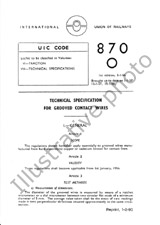We need your consent to use the individual data so that you can see information about your interests, among other things. Click "OK" to give your consent.

UIC B169/RP36-1ed.
Project - Defect Tolerance Concept (DTC) - Permitted defects and surface properties for axles under maintenance
Translate name
STANDARD published on 1.12.2013
The information about the standard:
Designation standards: UIC B169/RP36-1ed.
Publication date standards: 1.12.2013
SKU: NS-1190384
The number of pages: 145
Approximate weight : 466 g (1.03 lbs)
Country: International technical standard
Category: Technical standards UIC
Annotation of standard text UIC B169/RP36-1ed. :
Though the number of axle breakages is at an all-time low, the sector is still striving to further improve the in-service behaviour of these safety-critical components. The axles used in Europe are mostly UIC-standard or based on uniform UIC and EN design and supply requirements. This projects goal was to define the permissible surface features of axle defects for maintenance, in order to avoid axle breakages due to surface defects and ensure the cost-effective operation and maintenance of vehicles. Based on the requirements for a "defect tolerance concept" as defined by DIN 27 201 - 11, an analysis was conducted comprising a bibliography, a survey on maintenance and cases of axle damage amongst the European railways, crack initiation tests, and experimental determination of stress resistance. The outcome is an appraisal of defects on the bare axle surface after removal of coating during maintenance, and the classification of such defects into defect classes. The working hypothesis was further refined during the course of the project. UIC defect classes 1 to 4 were defined, each comprising a verbal description, visual depiction, and information on surface roughness. As a result of the project, recommendations are made for the tolerance criteria to be applied on the basis of these UIC defect classes.
"+
"
Name:Projekt - FTK Radsatzwellen - Zulässige Fehler und Oberflächeneigenschaften von Radsatzwellen in der Instandhaltung|
Die Anzahl der Radsatzwellenbrüche liegt auf einem historischen Tiefstand, trotzdem ist das Bestreben des Sektors die weitere Verbesserung des Betriebsverhaltens dieser sicherheitsrelevanten Komponente. Die in Europa eingesetzten Radsatzwellen sind im Regelfall UIC standardisiert bzw. basieren auf den einheitlichen Auslegungs- und Lieferanforderungen entsprechend UIC und EN. Ziel des Projektes war die Definition zulässiger Oberflächeneigenschaften von Radsatzwellendefekten in der Instandhaltung zur Vermeidung von Radsatzwellenbrüche ausgehend von Oberflächenschäden und um einen wirtschaftlichen Betrieb / Instandhaltung der Fahrzeuge zu gewährleisten. In Anlehnung an die Vorgaben eines Fehlertoleranzkonzeptes nach DIN 27 201 - 11 wurde eine Analyse mit Bibliographie, Umfrage zur Instandhaltung und zu Schadfällen an Radsatzwellen bei den europäischen Bahnen, Rissinitiierungsversuchen und experimentelle Ermittlung der Beanspruchbarkeit durchgeführt. Ergebnis ist die Bewertung der Defekte an der freien Wellenoberfläche nach dem Entfernen der Beschichtung im Rahmen der Radsatzinstandhaltung und die Einteilung in Fehlerklassen. Die Arbeitshypothese wurde im Rahmen des Projektes weiterentwickelt. Es sind die UIC Fehlerklassen 1 bis 4 mit ihrer verbalen Beschreibung, bildlichen Darstellung und informativen Angabe der Oberflächenrauheit erarbeitet worden. Im Ergebnis des Projektes werden in Abhängigkeit von der UIC Fehlerklasse Empfehlungen für anzuwendende Toleranzkriterien gegeben.
"+
"
We recommend:
Technical standards updating
Do you want to make sure you use only the valid technical standards?
We can offer you a solution which will provide you a monthly overview concerning the updating of standards which you use.
Would you like to know more? Look at this page.



 Cookies
Cookies
